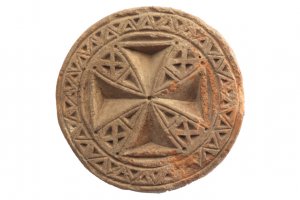Metal threshing board
The Metal or wooden threshing board is an important agricultural tool used for threshing cereals. It is a wide construction with spikes (sharp objects made of iron or wood or sharp flint stones) at the bottom of the surface, where it was dragged by the animals and separated the grains of the cereals from the chaffs. In many areas the threshing board was made by skilled craftsmen. For the threshing of legumes (beans, lentils, etc.) special small pieces of single-piece wood, usually beech, were used, on which sharp objects were attached to cutters.
Cereal threshing was usually done in July and was a celebration for the whole family. After the harvest, the farmers transported the sheaves to the threshing floor, a level, circular, paved or earthen area, which existed in the field, or at the edges of the settlements. In the center of the threshing floor was a wooden pole on which a rope was tied that held the animals horses or mules as it rotated and dragged the threshing board that crushed the chaffs and separated the grains. The threshing board was tied to the animals with the side that has the spikes facing down. The farmer stood on it ,and guided the animals that moved in both directions. First wrapping the rope from outside to the center and then the animals followed in the opposite direction by unrolling the rope the first animal from inside went last outwards. In this way threshing was achieved throughout the threshing floor. Next came the winnowing, in which pitchforks and shovels were used to separate the grain from the chaff with the help of the wind.


